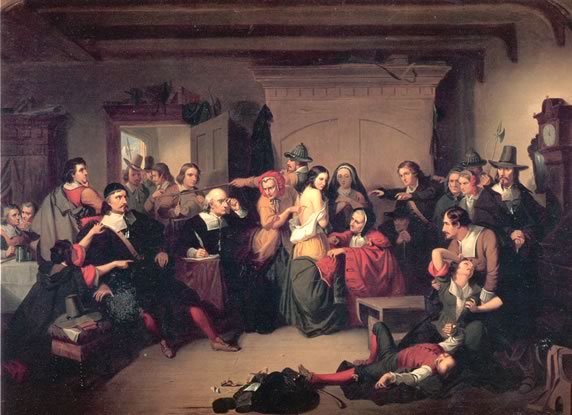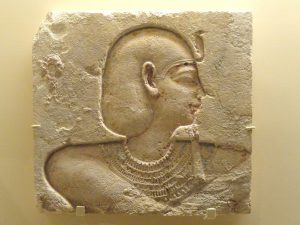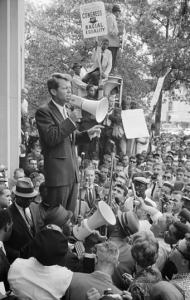Why would adults in Salem, Massachusetts in the 1690s take the accusations of nine year old girls seriously? During the seventeenth century, New England had grown diverse. The people living in the communities were of different backgrounds. But in the 1690’s there was an apparent outbreak of witchcraft. The most famous of these outbreaks was the event in Salem, Massachusetts in 1692 that stirred up the Salem community and soon spread to other communities.
The widespread hysteria over witches was all over the town after an accusation of witchcraft was made in January 1692. A group of young adolescent girls met in the home of Samuel Parris, a Puritan pastor in Salem. The pastor had a nine year old daughter, Betty. Betty and her cousin Abigail were fascinated by the voodoo tales and tricks told to them by the family slave. The family slave, Tituba, was the one whom the little girls had sought after for entertainment.1 It was not long after their time spent with Tituba, when the girls began to behave strangely; seeing visions, babbling at times, and lapsing into trances. The Puritans thought that these behaviors were of witchcraft, as the work of the devil. People in Salem began believing the girls, and charged Tituba and two other village women for practicing witchcraft on them. Two men, John Hathorne and Johnathan Corwin of Massachusetts, were called to do a legal examination of the women. The Puritans followed the Old Testament law. This was how they assessed the examinations. Scripture had a statement that said witches were not able to live. The two men knew exactly what they had to do. The examination was done on these women of Salem by looking for a certain mark on the body: a wart or tit. This specific mark was said to be the place where the devil and his demons would take blood out of the witch.2 Many of the women accused were of lower status in the community.

Research shows most of the accused witches were middle-aged women, widowed, with few or no children. Also, if the woman had been involved with domestic conflicts, they were accused. The women were accused of crimes and appeared to be dangerous by their neighbors. Women in Salem who inherited or possessed land were also accused of witchcraft.3 The accusations towards these women were out of the ordinary and seemingly wrong. One must first think about the view of women during this time. They were undermined and portrayed as having no power or knowledge of such things; they were subservient to the men in the community. Not only were low class women accused of witchcraft, but as time passed, superior women were accused as well.4
On October 29th, the Salem Witch Trials were called to an end. Governor Phips dismissed the Court and that marked the end to the witch hunt craze. Many were disappointed about the ending of the trials, but many were glad to return to work.5 The community in Salem blamed Pastor Parris for letting the innocent die. The people of the Salem church also voted to void his salary. In the following years, those family members of the deceased were restored their good names. The families were awarded a compensation for all the financial loses they went through during such tragic times. Increase Mather, a pastor of the Boston Puritan Church, wanted the people to do away with the court because he believed they put innocent people to death.
The Witch trials took on an important role in American History. The trials became a tragic and memorable moment in history. Generational, racial, and sexual hostility, opposition to law, social stresses, and food poisoning were all causes as to why the people had anxieties that found release in the witch hunt craze. The witch hunts became searches for scapegoats; the community leaders were looking for anyway possible to ease the community’s anxieties.6
- Kenneth P. Minkema, “In the Devil’s Snare: The Salem Witchcraft Crisis of 1692,” The Christian Century, no. 8 (2003): 37. ↵
- Salem Press Encyclopedia, January 2015, s.v. “Salem Witchcraft Trials,” by Warren M. Billings and Kimberly Manning. ↵
- Alan Brinkley, American History, 15th ed., vol. 1: to 1865 (2 Penn Plaza, New York, NY 10121: McGraw Hill Education, 2015), 86-87. ↵
- Salem Press Encyclopedia, January 2015 s.v. “Salem Witchcraft Trials,” by Warren M. Billings, Kimberly Manning. ↵
- Salem Press Encyclopedia, January 2015 s.v. “Salem Witchcraft Trials,” by Warren M. Billings, Kimberly Manning. ↵
- Salem Press Encyclopedia, January 2015 s.v. “Salem Witchcraft Trials,” by Warren M. Billings and Kimberly Manning. ↵



178 comments
Madeline Emke
In my sophomore year, my literature teacher dedicated a small portion of time to discuss the Salem Witch trials, but the discussion only included the play The Crucible by Arthur Miller because the class was an American Literature class. However, I performed independent research on the topic because I wanted to know more. I like how the article focused on a brief overview of what happened instead of diving into individual cases as most scholars or books do. The overview was super nice because I liked learning about the general outcomes of the Witch Trials.
Eric Hernandez
I thought this was pretty crazy and even almost unrealistic as I read through the article. It’s chilling to know that an event like this, happened. It’s really scary having to even think of anything being involved in witchcraft but, it’s even more terrifying to know that innocent women were being punished and even sentenced to death. It makes me think, why and how would something this evil exist.
Diego Oviedo
It’s interesting how the first case of The Salem Witch Trials came about. However, how they were judged or accused of being witches was based on the old testament. I was surprised by how the way of identifying a witch was based on a wart in a specific place on the body. One thing that did not surprise me was that the accused were sometimes wrongfully accused but were still condemned to death just to satisfy the community. The history of The Salem Witch Trials is interesting and despite the things we still don’t know it allows one to ponder on the idea that what else don’t know.
Alexis Lopez
I really enjoyed this reading by Oscar Sepulveda. I liked that this article was able to give me more information on the first case of witchcraft and how and where it originated from. I thought it was interesting that many of the people that were accused of witchcraft were all woman. They were either middle-aged or widowed. This article really gives you a lot of information about the witchcraft in Salem and the trials that took place during that time.
Reagan Clark
This article gives a brief overview of the trials. I have always read about the trials in books that I have read. It is tragic what happened in the trials. A bunch of innocent women died because they were accused of witchcraft. I like how this article briefly shows which women were accused. It seems that most of the women accused were the ones who were different, the ones society rejected. I wish that this article went into more detail though.
David Castaneda Picon
This is a very interesting article. I have read about the story of the Salem witch trails once when I was in high school, I find the story very curious, why people at that time used to think of women that did not had children or husband, as witches assuming that they did witch craft. Clearly this event has shaped America. I think it is very sad that many innocent people were convicted and put to death just because assumptions or false accusations, and I agree with the author, this event is tragic and memorable in American history.
Kennedy Arcos
I have always been intrigued by the Salem Witch Trials. During high school, I remember learning about the witch trials quite often. It’s really sad how innocent lives were taken just because of false accusations and paranoia. I also recognized the names mentioned in the article, which surprised me. This is a pretty interesting part of history, and this article was very eye opening.
Meadow Arriaga
The Salem Witch Trials time period is very interesting. Woman have constantly been dealing with double standards, differing between generations. These women who have lost their husband and children, or never had either were suspected with some kind of witch craft probably amongst other struggles. Also, simply having a criminal record was dangerous for a woman shows how different they treated women from men. I find it extremely intriguing to think about the struggles and conditions women were put through in these time periods.
Micheala Whitfield
I’m intrigued on the day the Witch Trails ended. October 29th, two days before Halloween. Just a coincidence I’m sure. There has been so much literature on the Salem Witch Trails, all to which glorify the idea of witches, even though a group of people falsely accuse and killed them. This article shows the brutality of the actions people took towards innocent individuals. I enjoyed seeing the emphasis on grown adults believing in children, who we know at least in this decade, can tell stories of all kinds. Makes you wonder why would they make up such a story and what guilt did they have to live with. Very intriguing article.
Sara Guerrero
The witch trials in Salem was definitely a difficult event for women and would be accused for actions that did not even pertain to witch activity. I believe that the whole witch trials was an event of mass hysteria throughout the colonies sort of like gold fever. I have heard of Tituba and the girls and some people believe now that the cause of the girls strange behaviour could’ve been caused by something in the environment. Really enjoyed this publication and to relearn this part of history.